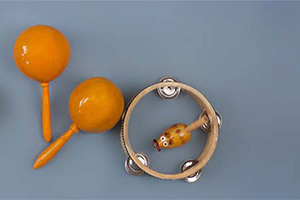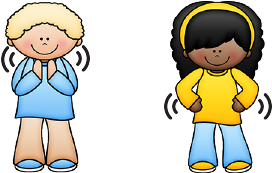Prep. Lesson 18. Active listening and inner hearing
Prior learning:
Duration: 30 minutes
Materials: None
Keywords: Beat, singing, chanting, partners, rhymes, circle games
Difficulty: ![]()
![]() If students listen and perform another task, the term active listening is used. Examples would include humming along to a melody, listening and clapping to a steady beat, or when they hear a specific element of music or a word, they will raise a hand.
If students listen and perform another task, the term active listening is used. Examples would include humming along to a melody, listening and clapping to a steady beat, or when they hear a specific element of music or a word, they will raise a hand.
Students are asked to listen to a specific part of the music and act appropriately with an action from a teacher-led cue or prompt. Active listening aids in students' ability to develop speech and language skills, auditory perception, and ability to follow verbal instructions.
 Melodic development
Melodic development
![]() Students listen and use audiation (inner hearing or head voice) to identify a song.
Students listen and use audiation (inner hearing or head voice) to identify a song.
- Arrange students on the floor and explain that they must identify songs by listening attentively to hummed melodies.
- Begin with a familiar tune, such as 'Old Brass Wagon', and ask students to name the song and discuss how they recognised the song.
- Repeat the activity with different songs, like Starlight or Ickle Ockle, to encourage diverse listening experiences.
- Dr James Cuskelly's classroom video is a prime example of students effectively identifying hummed melodies.
- Engaging in regular active listening exercises fosters the development of inner hearing, a critical skill in musicianship.
 Rhythmic development
Rhythmic development
![]() Students listen and identify a song from a clapped rhythm only.
Students listen and identify a song from a clapped rhythm only.
- Choose a familiar song, such as Bell Horses or any other popular classroom tune that students have sung multiple times.
- Explain to students that they will identify a song by clapping its rhythm.
- With the class focused, clap the rhythm of the chosen song and ask if anyone recognizes it solely from the clapping.
- Request a show of hands and select a student to name the song. If their answer is incorrect, restart the process and choose another participant.
- Clap the rhythm again, inviting the class to clap along as you sing.
- Conclude the activity by having students clap and sing the song together, strengthening their rhythmic understanding and reinforcing the connection between rhythm and melody.
 Game
Game
![]() Students use inner hearing to correctly identify a cue at the end of a song.
Students use inner hearing to correctly identify a cue at the end of a song.
- Arrange students in a circle, holding hands.
- Instruct them to walk left on the beat until the song's conclusion, at which point they jump, face the opposite direction, and exclaim, "Boom!" Repeat the process in the new direction.
- Next, have students step in a circle while clapping the song's beat without singing.
- Emphasise that on the final beat, everyone should collectively say, "Boom!"
- This activity encourages inner hearing, rhythmic understanding and coordination, enhancing students' musicianship and group cohesion.
- For optimal engagement, ensure students are highly familiar with the program's songs before incorporating them into activities.
Students should learn the repertoire thoroughly before any further exploration.
 Part work
Part work
![]() Students use visual cues to identify and sing a song.
Students use visual cues to identify and sing a song.
- Project the images on the board.
- Ask students to identify each image and which song it represents.
- For every correct answer, lead the class in singing the correct song.






 Video
Video
![]() Students discover more about inner hearing as the Piggles explore sound and silence.
Students discover more about inner hearing as the Piggles explore sound and silence.
 Farewell
Farewell
![]() Reinforces students' pitch ability through listening, imitation, and repetition. 'Good morning' or 'Bee, Bee, Bumblebee' are good examples.
Reinforces students' pitch ability through listening, imitation, and repetition. 'Good morning' or 'Bee, Bee, Bumblebee' are good examples.
Suggested lessons
Prep. Lesson 19. Rhythm patterns II
 Students explore rhythm by using body percussion and percussion instruments. AC9AMUFP01
Students explore rhythm by using body percussion and percussion instruments. AC9AMUFP01
Prep. Lesson 20. Body percussion
Students discover how to use their body as an instrument through body percussion. AC9AMUFP01
F.21. Pitch II - Exploring high and low sounds
Students improve their listening skills and discover more about high and low sounds. AC9AMUFP01


